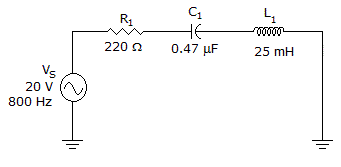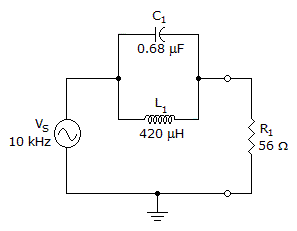Discussion
Home ‣ Electronics ‣ Quantities and Units See What Others Are Saying!
- Question
The difference between scientific and engineering notation is
Options- A. powers of ten representation
- B. single vs. multiple digits before decimal point
- C. groupings of multiples of three digits
- D. All of the above
- Correct Answer
- All of the above
- 1.

What is the voltage across the capacitor in the given circuit?
Options- A. 6.8 V
- B. 11.9 V
- C. 16.1 V
- D. 22.9 V Discuss
- 2. The diode's characteristic curve shows that current increases when voltage increases.
Options- A. True
- B. False Discuss
- 3. It takes 4 µs for the output voltage of an op-amp to rise from ?14 V to +14 V. The slew rate of this op-amp is 3.5 V/µs.
Options- A. True
- B. False Discuss
- 4. A JFET has 3 terminals: gate, drain, and source.
Options- A. True
- B. False Discuss
- 5. If an open capacitor is checked with an ohmmeter, the needle will:
Options- A. stay on zero
- B. stay on infinity
- C. move from zero to infinity
- D. move from infinity to zero Discuss
- 6. The resistive track of a rheostat or potentiometer can be classified as having either a linear or tapered resistance.
Options- A. True
- B. False Discuss
- 7. When a circuit consists of a capacitor and a resistor in series with a voltage source, and the voltage across the resistor is zero, then the capacitor is:
Options- A. charging
- B. discharging
- C. fully charged
- D. fully discharged Discuss
- 8. The two most common types of analog-to-digital converters discussed in this chapter were the ______.
Options- A. linear converter and the analog converter
- B. linear converter and the successive approximation converter
- C. flash converter and the analog converter
- D. flash converter and the successive approximation converter Discuss
- 9. What is the total power in the circuit?

Options- A. 170 mW
- B. 1.7 W
- C. 17 W
- D. 170 W Discuss
- 10.

If the output voltage were taken across the resistor in the given circuit, the circuit would be a band-stop filter.
Options- A. True
- B. False Discuss
More questions
Correct Answer: 22.9 V
Correct Answer: True
Correct Answer: False
Correct Answer: True
Correct Answer: stay on infinity
Correct Answer: True
Correct Answer: fully charged
Correct Answer: flash converter and the successive approximation converter
Correct Answer: 170 mW
Correct Answer: True
Comments
There are no comments.More in Electronics:
Programming
Copyright ©CuriousTab. All rights reserved.
